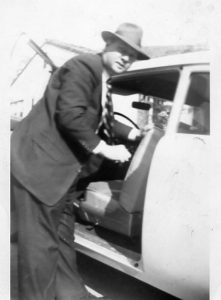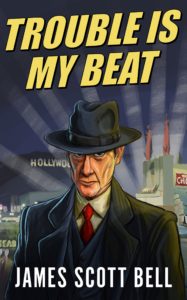- GYORGY, ___ CA5 ___, ___ CR3 ___ (23) #G061567:
Anaheim police officer McGlade was cruising with dope sniffing dog, Titan. An undercover cop contacted him to be on the lookout for a black pickup that had acted “suspiciously” at a motel known for drug activity.
McGlade spotted the truck and followed. When the truck made a quick lane change, causing another car to brake, McGlade pulled the truck over for a VC violation. Gyorgy was driving.
McGlade asked several questions, eliciting that Gyorgy was a registered sex offender. He then ordered Gyorgy out and told him to sit on the curb as they waited for backup. Another officer arrived, then McGlade patted Gyorgy down. Nothing found.
Now seven and a half minutes into the stop, McGlade told Gyorgy he was going to have Titan sniff the car. Gyorgy protested. Titan began sniffing.
After nearly twelve minutes, Titan alerted to the bottom seam on the driver’s door. The officers searched the interior of the truck and found methamphetamine and a glass pipe with white residue indicative of having been used to smoke methamphetamine. Inside a backpack that was inside a cardboard box, they found an unloaded handgun, an empty magazine, and six live rounds of ammunition.
Gyorgy was charged with unlawful possession of drugs, paraphernalia, a firearm, and ammunition. His 1538.5 motion was denied.
The Court of Appeal, 2-1, reversed and remanded.
In RODRIGUEZ, 575 US 348 (15), the U.S. Supreme Court held that the “tolerable duration of police inquiries in the traffic-stop context is determined by the seizure’s mission—to address the traffic violation that warranted the stop…” and may last no longer than to effectuate that purpose.
Here, the court holds that “[e]xamining the totality of the circumstances, we conclude the police were not reasonably diligent in completing the traffic stop’s mission.”
Moore, Acting PJ, filed a dissent.
P-C for Search Warrant Seeking DNA Supported by “Investigative Genealogy”
- Lepere, 91 CA5 727, 308 CR3 558 (23) #G061393:
In 2020, a cold case file was assigned to Anaheim Police Detective Julissa Trapp. The case was a 1980 rape-murder of a 79-year-old woman. A rape kit was booked into evidence.
In 2002, a forensic scientist was able to extract male DNA from the rape kit. There was no match in the databases.
Detective Trapp sought help from the FBI, which uploaded the unknown DNA profile to a company that was able to generate a single nucleotide polymorphism profile. This data was uploaded to an genealogy website, which the FBI used as an “investigative lead” identifying Def., now living in New Mexico, as “a person of interest.”
An officer in New Mexico completed an affidavit in support of a search warrant of Def’s home. Trapp and other officers executed the search in the early morning hours, seizing beer cans and other items from Def’s outside trash can. A couple of weeks later, Trapp received a crime lab report linking DNA collected from one of the beer cans to the DNA profile obtained from the 1980 Anaheim murder victim.
Def. was arrested and put on trial. His 1538.5 motion to suppress the DNA evidence was denied. The Court of Appeal, per Moore, Acting P.J., affirmed.
Here, the genealogical investigation by the Orange County Crime Lab and the FBI established a possible DNA connection between Lepere and the 1980 murder. Further, there was corroborating evidence that Lepere may have been near the victim’s apartment in Anaheim, California, at about the time of the 1980 murder. In short, we find there was “a fair probability . . . that a search” of Lepere’s outside trash can “would uncover” circumstantial DNA evidence linking Lepere to the commission of the 1980 Anaheim murder. (See Kraft, supra, 23 Cal.4th at p. 1040.) Thus, we hold that the New Mexico magistrate had a reasonable basis for issuing the search warrant, and the trial court properly denied Lepere’s pretrial motion to suppress the DNA evidence.
The court went on to note that even if the S-W affidavit were not sufficiently detailed, the Good Faith Exception would preclude suppression.
Geofence Warrant Was Not Overbroad
- Price, ___ CA5 ___, ___ CR3 ___ (23) #E078954:
Last Poop Sheet we reported on Meza, 90 CA5 520 (23), involving a geofence warrant, used to access device location data gathered by large tech companies, like Google. While this data is typically “anonymized,” it can be “used in conjunction with other investigative techniques to tie devices to specific users—and identify persons of interest in a criminal investigation.” [Quoting Meza]
In Meza, the court found the warrant lacking in particularity and was therefore overbroad. But the search was saved by way of the Good Faith Exception.
Here, Riverside County Sheriff’s Investigator Ryan Deanne was the lead investigator in the shooting death of one Jovany R. He was also the affiant for the geofence warrant.
Deanne testified about the investigation, the geofence warrant, and three other warrants seeking Price’s Google e-mail (Gmail) account data and cell phone records, issued after Price was identified as a suspect in the shooting based on location data and identifying information obtained from Google pursuant to the geofence warrant. Deanne also testified about his observations at the scene of the shooting, and his interviews with other investigating officers and witnesses, including Jovany R.’s brother, Samuel R., who was with Jovany R. at the time of the shooting and witnessed the shooting.
***
The geofence warrant sought “all identifying information” according to the Google “production protocol” for Google accounts reporting “location history data generated from devices that reported a location” within the geofence. As Deanne testified, the warrant limited the geofence to the front yard of Jovany R.’s home, where the shooting occurred, and the street in front of the home (Homestead) for the length of two houses in each direction, where Samuel R. saw the two suspects flee in separate directions after the shooting. The street portion of the geofence on Homestead abutted the yards of 11 homes, including Jovany R.’s front yard. The warrant requested location data in the geofence between 10:00 p.m. and 10:22 p.m. on October 29, 2019, a 22-minute period encompassing the time of the shooting, according to 911 calls and the times officers responded to the scene of the shooting. The warrant included an aerial photograph of the geofence marked by latitude and longitude coordinates, and areas immediately around the geofence.
***
Here, the geofence warrant was a model of particularity in geographic scope and time period.
Additionally, as in Meza, the court found the Good Faith Exception would also apply.

